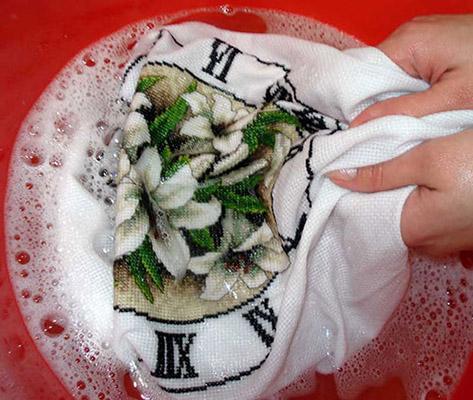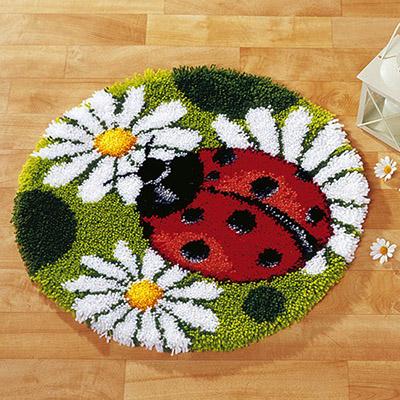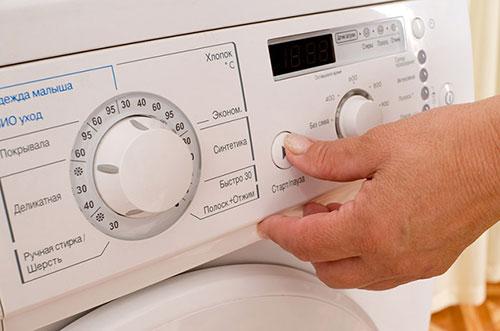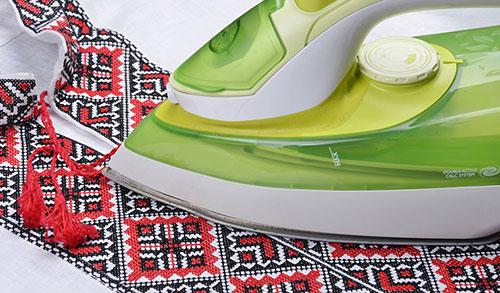The question of washing embroidery arises at the final stage of work. Many needlewomen argue that the product must be washed only if there is significant contamination or the appearance needs to be significantly updated. Even if the work is done competently and accurately, and before each entry you wash your hands thoroughly, the needlework should still be refreshed. embroidery must be washed and ironed after its completion. Then the material and stitches acquire their final elastic shape, the colors of the threads become brighter, the traces of the hoop disappear, and the product gets a complete and neat look. We will figure out how to care for and clean such delicate work.
Washing rules

To preserve the attractive appearance of such gentle creativity, they resort hand wash only. To successfully and painlessly wash cross-stitch on canvas, satin stitch or ribbons, follow these tips:
- In a small container, dilute a mild liquid detergent with warm water. You can replace it with an ordinary bar of laundry soap.
- Dip the embroidery in water, carefully and carefully rub the dirt. Thread stains are easy to remove with a toothbrush and detergent.
- For white fabrics, use soap to remove stains. Just rub the dirt with a bar, avoiding the weaving of the threads.
- Rinse thoroughly; conditioner is optional. Do not wring, blot with a dry terry towel. Do not leave the product near shedding laundry.
Carpet embroidery: how to care

Mistresses are most often wary of cleaning their creations.However, washing carpet embroidery is a must. Wherever the mat is located, the material still accumulates dust and pollution over time. For cleaning, you will need a minimum of tools and a little free time:
- Be sure to walk through the product first vacuum cleaner at minimum power. In this way, you will remove excess dust and dirt from the surface, and cleaning will be easier.
- Prepare warm soapy water and a soft sponge or brush. A mild shampoo or washing gel is suitable as a cleaning agent. The liquid formulation is gentler and dissolves faster than the granular powder. Dilute the soapy solution and use a damp sponge to scrub the mat. Do not wet the entire product, treat the surface locally.
Machine wash - last resort

Embroidery is recommended to be washed by hand. If you still decide to send the floss to the washing machine, follow these rules:
- Do not run the washing machine because of the small embroidery. Only non-shedding small things are placed in the drum, filling the space at least up to 1/5. If there is a lot of space left, add natural, non-dyeing linen: towels, napkins, handkerchiefs.
- Roll and pack carefully in a bag or laundry bag. This approach increases the chances of removing undamaged embroidery from the machine.
- Choose a mild, gentle detergent for washing delicate fabrics. Avoid harsh chemicals and bleaching powders. No conditioner or softener is required.
- Select a delicate or hand wash program, turn off the pre-soak. The water temperature must not exceed 30 ºC. Turn off the spin or set the value to 400 rpm.
How to dry and iron embroidery

The embroidery should not be wrung out.Lay the product on a horizontal, flat surface, spreading a light-colored terry towel. Straighten and straighten the floss as much as possible. If necessary, blot with a soft cloth. Leave to dry, turning occasionally.
Remember that bright sunlight, heat from heaters, dampness and poor ventilation are the main enemies. Don't wait until it's completely dry. When the fabric is slightly damp, turn on the iron. Heat the appliance to the minimum temperature, set the steaming mode (steam). Iron the fabric through cheesecloth or light cotton handkerchief. Leave on a horizontal surface until completely cool. You can start decorating the work!
